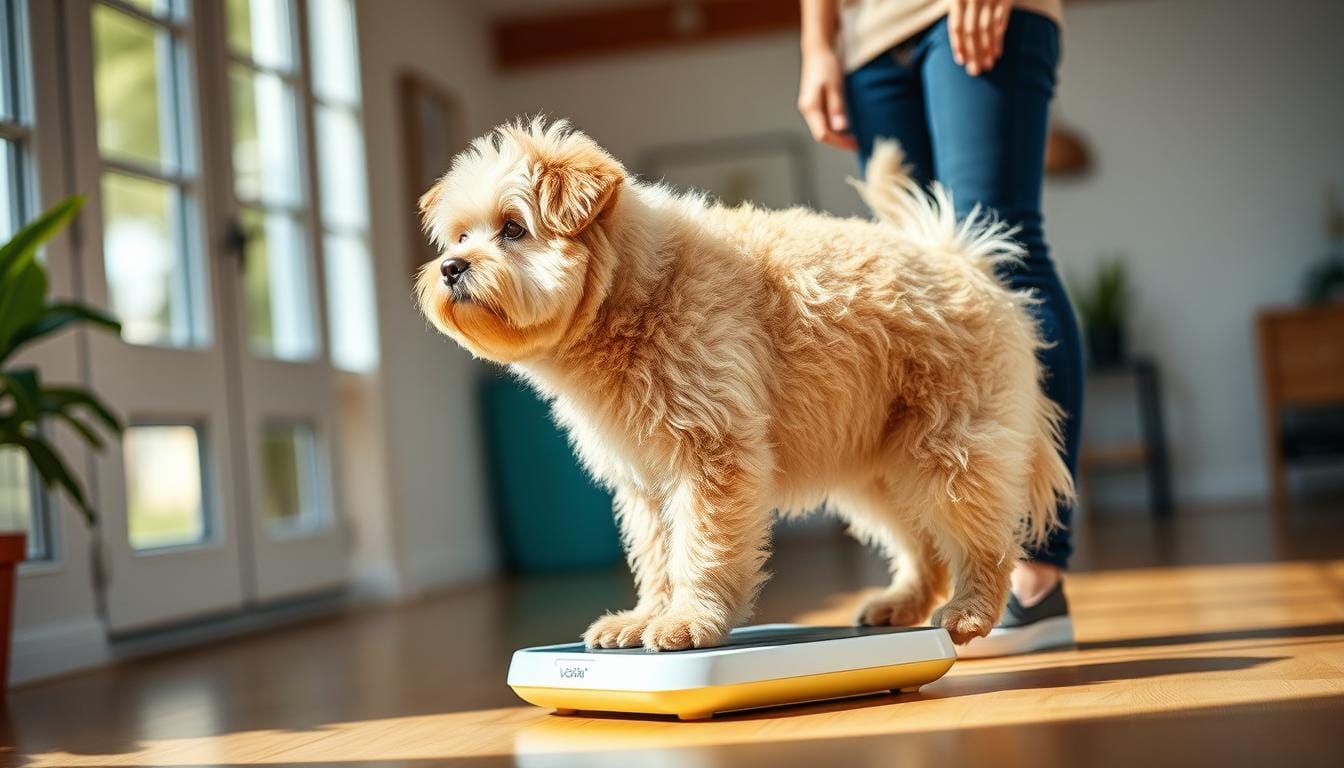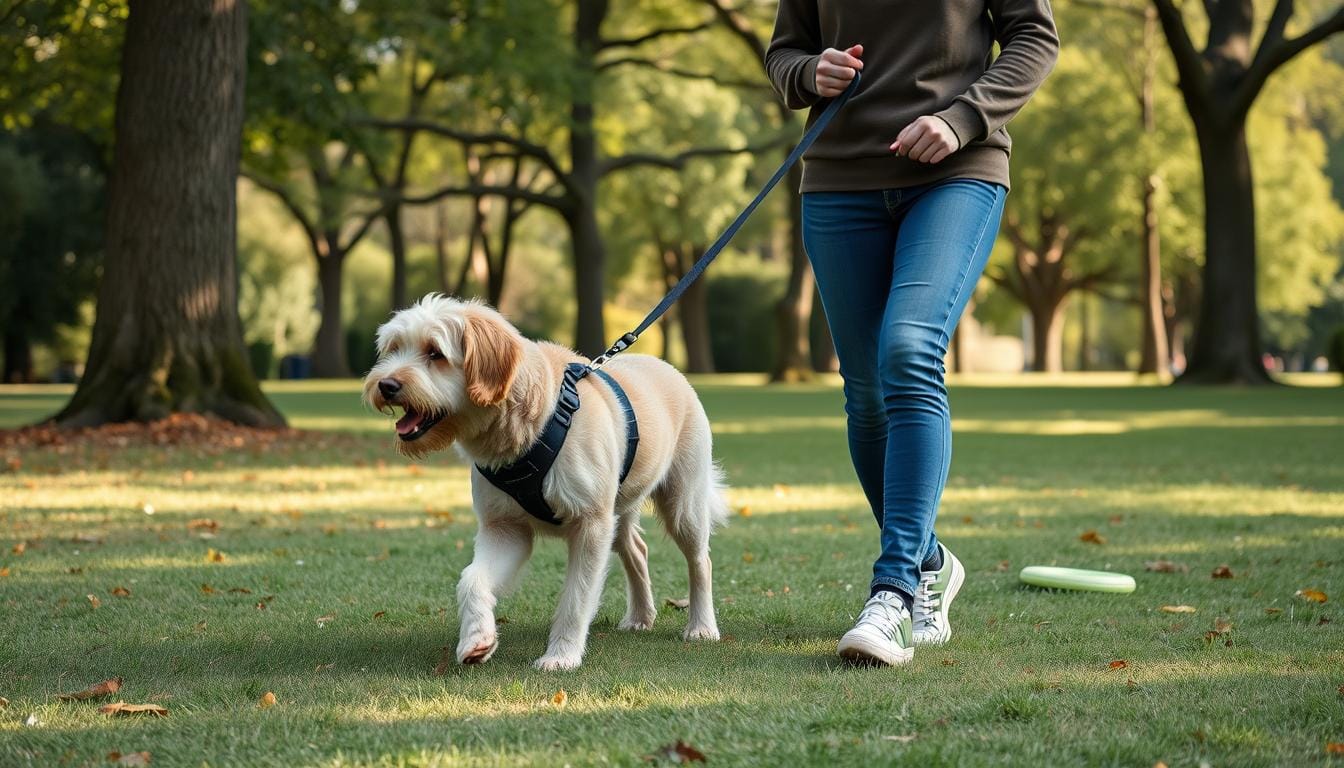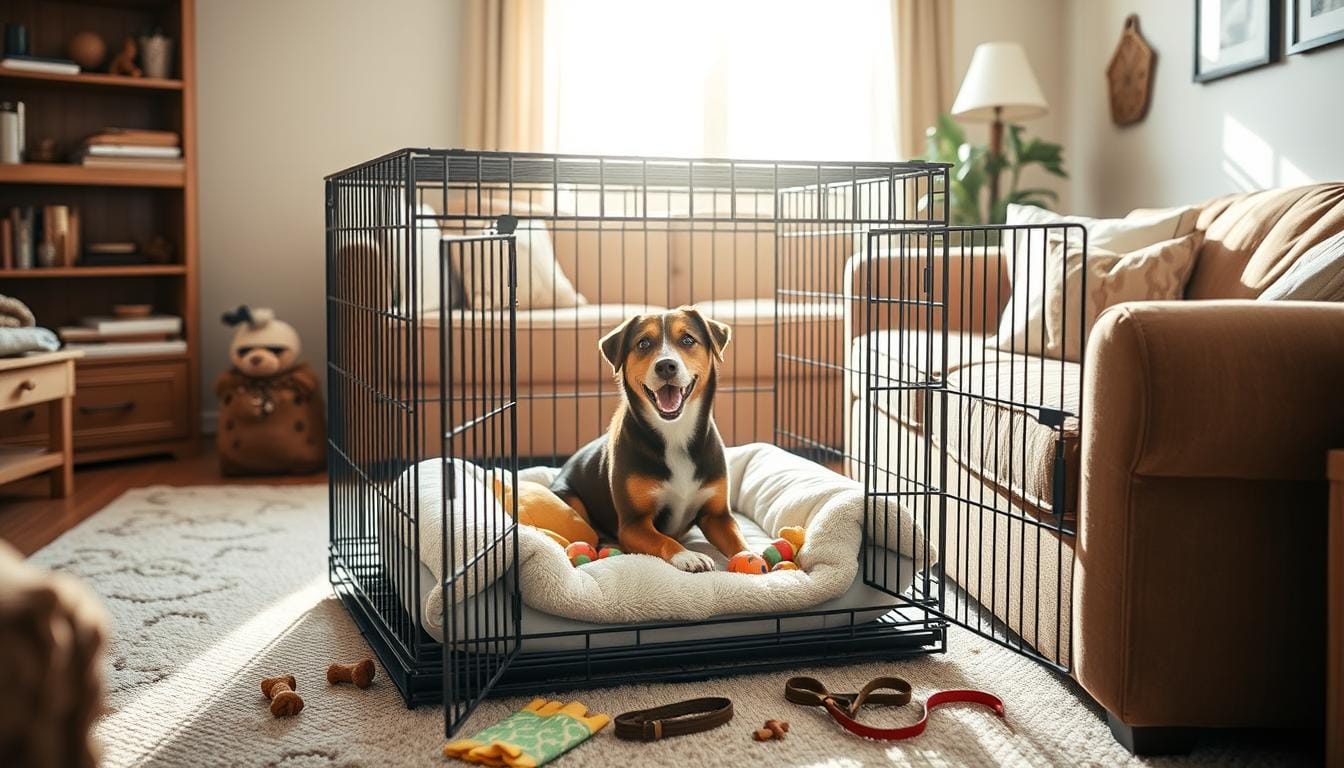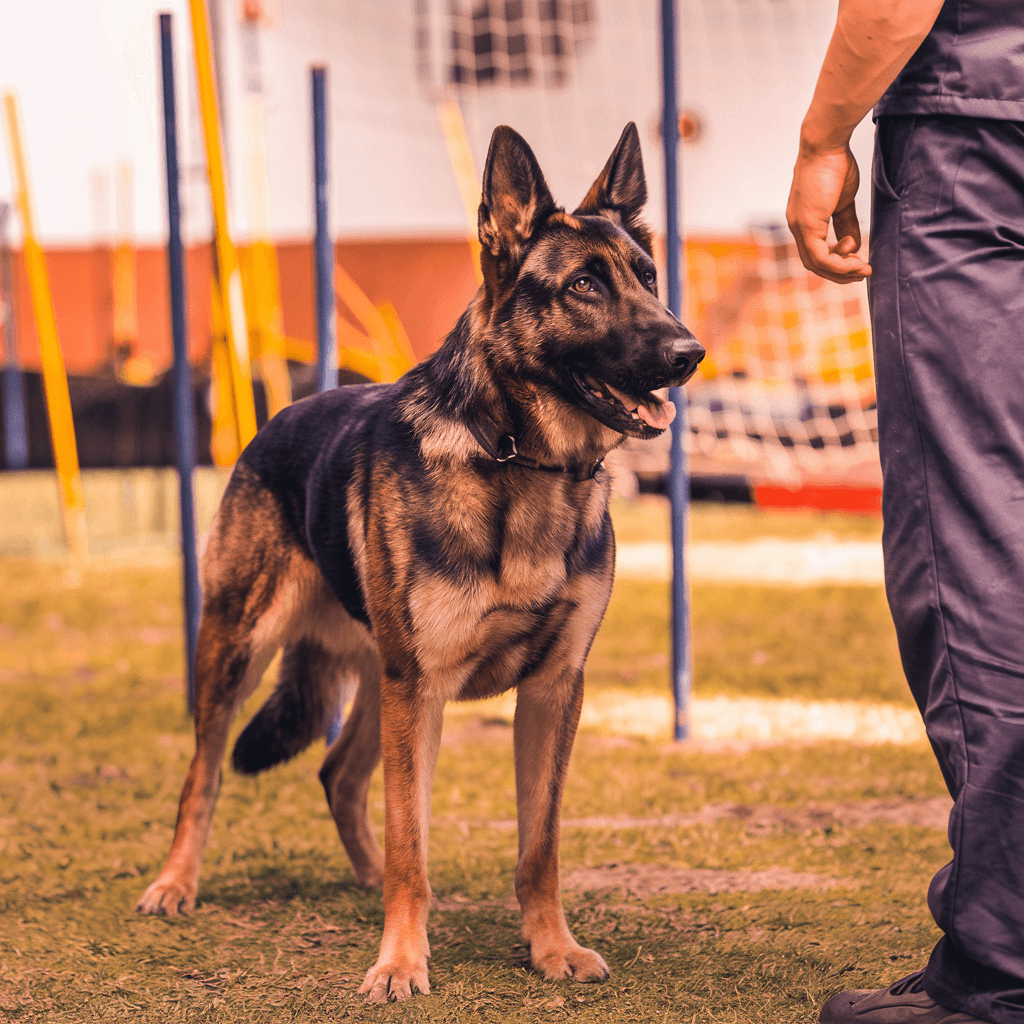Is your furry friend carrying a few extra pounds? You’re not alone. In the U.S., over half of our canine companions are overweight. But don’t worry! We’re here to guide you through safe and effective ways to help your dog shed those extra pounds and improve their overall health.
Dog weight loss isn’t just about cutting back on treats. It’s a combination of a healthy dog diet and the right amount of dog exercise. Just like humans, dogs need a balanced approach to achieve and maintain a healthy weight. By focusing on proper nutrition and regular physical activity, we can help our pets live longer, happier lives.
Tackling canine obesity is crucial for pet health. Excess weight can lead to various health issues, from joint problems to heart disease. But with the right strategy, we can turn things around. Let’s explore how to create a tailored plan that works for your unique pup.
Key Takeaways
- 56% of dogs in the U.S. are overweight or obese
- Weight loss for dogs is 60-70% diet and 30-40% exercise
- Consult a vet before starting any weight loss program
- Aim for a healthy weight loss of 3-5% of body weight per month
- Regular exercise and portion control are key to success
- Family involvement is crucial for long-term weight management
Understanding Canine Obesity and Its Health Risks
Canine obesity is a big problem in pet health. In the United States, over half of all dogs are overweight or obese. This is a serious threat to their health and life span.
Current Statistics on Dog Obesity in America
The numbers are alarming for canine obesity in America. More than 50% of dogs in North America are overweight. Dogs are considered overweight when they weigh 10-20% above their ideal body weight. They are obese when they weigh 20% or more above their ideal weight.
Health Complications of Overweight Dogs
Excess weight in dogs can lead to many health problems. Overweight dogs may live up to 2.5 years less than healthy-weight dogs. The risks include:
- Arthritis
- Heart disease
- Diabetes
- Liver disease
- Skin conditions
- Cancer
Fat tissue in dogs is active and secretes hormones that cause diseases. It’s important to prevent obesity in dogs for their health.
Recognizing Signs of Obesity in Dogs
It’s important to recognize obesity in dogs. Signs include:
- Lack of visible waist
- Difficulty feeling ribs
- Reduced energy levels
Veterinarians use body condition scoring systems to assess a dog’s condition accurately.
| Weight Status | Percentage Above Ideal Weight | Health Risks |
|---|---|---|
| Normal | 0-10% | Low |
| Overweight | 10-20% | Moderate |
| Obese | 20%+ | High |
Veterinary Consultation and Health Assessment
Pet health begins with a detailed vet check. Before starting a weight loss plan for dogs, a vet’s assessment is essential. It ensures your pet’s safety and success.
Initial Health Screening
A thorough health check is the first step for your dog’s weight loss. This exam finds any health problems that could affect their weight or overall health.
- Complete blood count (CBC)
- Biochemistry profile
- Urinalysis
- Thyroid hormone testing
Older dogs might need X-rays to check for organ or bone issues.
Setting Realistic Weight Loss Goals
After the initial check, your vet will set realistic goals. A safe goal is usually 4-5% of total body weight lost each month. This slow pace helps your dog lose fat, not muscle.
Creating a Personalized Weight Loss Plan
Your vet will make a plan just for your dog. This includes figuring out how many calories your dog needs and creating an exercise plan. The plan will consider:
| Factor | Importance |
|---|---|
| Body condition score | Assesses fat coverage |
| Muscle condition score | Evaluates muscle mass |
| Lifestyle | Influences activity level |
| Medical conditions | May impact diet choices |
Remember, a vet-approved plan is crucial for safe and effective weight loss for dogs. It keeps your pet’s health as the main focus during their weight loss journey.
Proper Nutrition and Portion Control
A healthy dog diet is key for managing your pet’s weight. We’ll look at how to figure out dog calorie needs, control portions, and switch to a weight management food plan.
Calculating Daily Caloric Needs
First, understand your dog’s caloric needs. Age, size, and activity level matter. For example, big puppies need three meals a day until they’re 4 months old. Adult dogs’ needs depend on their weight.
Measuring Food Portions Accurately
It’s important to control portions to avoid overfeeding. Use a real measuring cup for accuracy. Adult dogs weighing 51-75 pounds might need 3-3¾ cups of food each day. Don’t leave food out all day. Instead, feed at set times and remove leftovers after 15 minutes.
Transitioning to Weight Management Food
When switching to a weight management diet, talk to your vet. They can recommend the best food and portion size for your dog. Senior dogs, aged 7-12 years, might need diet changes to avoid weight gain.
Here are more tips to support your dog’s weight loss:
- Aim for 10 to 15 minutes of exercise twice daily
- Cut back on treats or swap for healthier alternatives
- Feed multiple small meals throughout the day to stabilize blood sugar levels
- Keep dogs out of the kitchen during meal preparation to avoid extra calories
By following these tips and keeping a consistent healthy diet, you can help your dog stay at a healthy weight.
Establishing a Structured Feeding Schedule
A structured feeding schedule is vital for a healthy dog diet and effective weight loss. It’s best to feed your pet once or twice a day. This helps keep their metabolism and digestive system in check.
Controlling portions is crucial for managing your pet’s weight. Split their daily calories into set meals, avoiding free-feeding. This stops overeating and keeps their energy steady.

- Puppies: Three or more meals per day
- Adult dogs: Two meals daily
- Senior dogs: Smaller, more frequent meals
Make mealtime fun and slow with puzzle feeders or slow-feed bowls. These tools help control portions and keep your dog’s mind active.
| Dog Size | Feeding Frequency | Calorie Needs |
|---|---|---|
| Small (e.g., Chihuahua) | 2-3 times daily | Higher calorie density |
| Medium (e.g., Beagle) | 2 times daily | Balanced nutrition |
| Large (e.g., Great Dane) | 2 times daily | Joint-supporting diet |
Consistency is essential for a healthy dog diet and successful weight loss. Stick to your feeding schedule and adjust portions as your pet’s needs change.
Choosing the Right Diet for Weight Loss
Choosing the right diet is key for your dog’s weight management. We’ll look at different options to help you decide what’s best for your furry friend’s health.
High-Protein vs Low-Fat Options
High-protein, low-carb diets are great for dogs to lose weight. They help dogs burn fat and keep their muscles strong. Foods high in protein make your dog feel full longer.
Wet vs Dry Food Considerations
Wet foods have more protein and less carbs than dry kibble. This is good for dogs trying to lose weight. Some dogs prefer wet food, which can help them eat less.
Reading Pet Food Labels
It’s important to understand pet food labels for weight management. Look for high-quality protein sources first. Avoid foods with too many fillers or artificial additives.
| Nutrient | Ideal Range | Benefits |
|---|---|---|
| Protein | 25-30% | Maintains muscle mass |
| Fat | 6-10% | Provides energy |
| Fiber | 8-10% | Promotes fullness |
Treats should be less than 10% of your dog’s daily calories. Choose low-calorie treats to help with weight loss. Fresh food plans offer exact portions for your dog’s needs, making them a great choice for weight management.
Exercise and Physical Activity Guidelines
Regular dog exercise is key for pet fitness and healthy activity levels. Aim for 30 minutes to two hours of daily activity. This depends on your dog’s breed and health.
Age-Appropriate Exercise Plans
Different breeds need different exercises. Young dogs should avoid hard surfaces to prevent joint damage. Senior dogs might enjoy swimming. Always check with your vet for a custom plan.
Indoor vs Outdoor Activities
Outdoor activities like walks and hikes are great. Indoor games like obstacle courses or hide-and-seek are also good. Mix both to keep your pet active.

Building Exercise Tolerance
Begin with short sessions and gradually increase. Start with 20-30 minute walks, five times a week. As your dog gets fitter, add more challenging activities.
| Activity | Duration | Frequency |
|---|---|---|
| Walking | 20-30 minutes | Daily |
| Swimming | 15-20 minutes | 2-3 times/week |
| Agility Training | 15-30 minutes | 1-2 times/week |
Consistent exercise helps with weight management and improves health and behavior. Always watch how your pet reacts to new activities and adjust as needed.
Managing Treats and Rewards
When working on a healthy dog diet, it’s crucial to pay attention to treats. Many pet owners don’t realize that treats can make up a significant portion of their dog’s daily calorie intake. For effective weight management for dogs, we need to be mindful of the treats we offer.
Let’s look at some smart ways to incorporate treats into your dog’s weight loss plan:
- Limit treats to no more than 10% of daily calories
- Choose low-calorie dog treats like fresh veggies
- Break treats into smaller pieces for training
- Replace some food rewards with play or praise
Remember, up to 60 percent of dogs are overweight, with half considered obese. By managing treats wisely, we can help our furry friends maintain a healthy weight and live longer, happier lives.
“Excess weight can reduce a dog’s life expectancy by up to 2 and ½ years compared to dogs at a healthy weight.” – American Veterinary Medical Association
For dogs prone to weight gain, like Labradors and Golden Retrievers, it’s even more important to be strict with treats. Consider using healthy alternatives like green beans or small pieces of lean meat as low-calorie dog treats. This way, you can still reward your pup without derailing their weight loss efforts.
Monitoring Progress and Making Adjustments
Tracking your dog’s weight loss is key for their health. We’ll show you how to monitor their progress and adjust their plan for the best results.
Weekly Weigh-ins
Regular weigh-ins are essential for dog weight loss. Try to weigh your dog weekly, at the same time and on the same scale. This makes tracking progress easier. Healthy weight loss for dogs is 0.5% to 2% of their body weight each week.
Body Condition Scoring
Body condition scoring is a hands-on way to check your dog’s progress. It looks at fat coverage and muscle tone. Your vet can teach you how to do this at home. It’s a great tool for dog weight management, giving insights beyond just scale numbers.
Adjusting the Weight Loss Plan
Be ready to change your dog’s plan as needed. If weight loss is too slow or fast, adjust food or exercise. Studies show up to 60% of dogs are overweight, so don’t get discouraged by setbacks. If you’re not seeing progress, talk to your vet. They might suggest physical rehab, which has helped in weight loss programs for pets.
Remember, dog weight loss is a slow process. Stay committed to your pet’s health journey and celebrate small wins!
Maintaining Long-Term Weight Management
We’ve reached a crucial phase in our dog’s weight loss journey. Keeping the pounds off is just as important as shedding them. A healthy dog diet and consistent exercise routine are key to obesity prevention in dogs. Let’s explore how to maintain your pet’s health long-term.
Preventing Weight Regain
Regular weigh-ins and body condition assessments are vital. We should aim for monthly check-ups to catch any weight fluctuations early. Remember, keeping your dog at a healthy weight can add up to two years to their life span. It’s worth the effort for your furry friend’s well-being.
Lifestyle Modifications
Sticking to portion control and daily exercise is crucial. Quality dog food that meets AAFCO guidelines should make up 90% of your dog’s diet. Treats can be part of a healthy dog diet, but limit them to 10% of daily calorie intake. Regular physical activity tailored to your dog’s age and breed is essential for pet health.
Family Involvement
Everyone in the household plays a role in your dog’s weight management. Educate family members about the importance of sticking to the feeding plan. Unauthorized treats can quickly derail progress. By working together, we can ensure our dogs lead healthier, happier lives. Remember, a lean dog is more likely to avoid obesity-related health issues and enjoy increased vitality and energy.
















